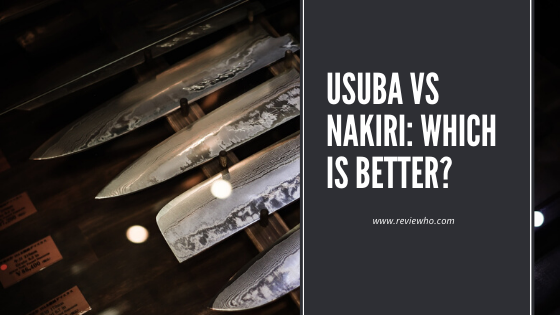These two kitchen knives are, from the uneducated standpoint of an average person or amateur chef, very similar. They are both made specifically to chop vegetables, are both of Japanese origin and even both look similar, but while experts have their reasons and trade secrets, how is a regular person supposed to know the difference between the two?
In this article we hope to give you more information about how these two beautiful knives are different, allowing you to make a more informed decision on which knife is right for you. Or maybe you’re just curious, either way, let’s get started!
What is an Usuba knife?

Let’s begin by looking at the Usuba bōchō. Its name alone literally translates to ‘thin blade’ so you can already see that this is a quality knife. This is the knife that, if you visit Japan, are more likely to see used by a skilled, professional chef. It is one of the three main knives that Japanese kitchens rely on and there are certain aspects of it that reflect this professional usage.
In traditional Japanese cuisine, one of the first knives that a new or in training chef needs to master is the Usuba, it’s harder to use than you would think and the masters who make it look easy are not all that common. Regular or amateur chefs will likely use this knife slowly and deliberately due to its heavier than normal weight although this added weight does make the Usuba ideal for fine decorative cutting.
An Usuba knife is also forged with a single bevel, this means that only one side of the blade is ground and sharpened while the other remains flat. This creates an incredibly strong blade that is extremely sharp if you know how to sharpen it.
This brings us to our next point, an Usuba knife due to the single bevel, is fairly difficult to sharpen. It is much harder than sharpening a traditional western knife and requires plenty of practice to perfect, most amateur chefs will likely have difficulty sharpening this blade.
Usuba knives also boast the option of longer blades if you should so choose one, along with elegant Japanese handles may be enough to sway you if money is of no issue as they truly are utterly stunning pieces of hardware.
I say if money is of no issue for a reason, the professional reputation, and quality of this knife also means that the price of one of these is far higher than that of the Nakiri. For reference, a decent Nakiri knife will start at around $60 whereas a good Usuba will start at around $150 and the price will only climb as you increase the quality.
Due to its larger price tag and the added difficulty in use and sharpening, this is a knife probably best left to professional chefs or experienced amateurs who will be able to make good use of the intricate work possible with this blade.
Suggested Reading: 5 Best Kitchen Knife Sets For The Money
What is a Nakiri knife?

Next up is the Nakiri, this knife is perfect for cutting high volumes of vegetables without the need to be as precise. Now don’t get us wrong, you can absolutely still practice Japanese cutting techniques but with the Nakiri you can also enjoy using it as an everyday vegetable knife.
It is not quite as delicate as the Usuba and is far easier to sharpen, being a double-beveled blade, it is closer to the blades traditionally used in the west and this is made clear by the methods in which it can be sharpened. You can use practically any home cook standard tools such as a whetstone, a Lansky kit, or ceramic wheels
Another feature of the Nakiri is that it will be noticeably lighter than its counterpart, almost half the weight in fact even if the knives are the same size. They are also available with western handles so they will feel more natural to a western chef who wishes to start learning a new skill or just wants to add another tool to their inventory.
The Nakiri is a perfect blade for high volume chopping and, while it can be used similarly to the Usuba, is far more suited to repetitive and rougher use on the chopping board thanks to the lighter weight blade that is far easier to sharpen.
You would be unlikely to find this knife in a professional Japanese kitchen, but that does not mean it has no use for amateur cooks. At a vastly cheaper price, this knife is a great starting point if you’re new to Japanese cooking and has the potential to make you fall in love with the new style of cooking.
So which knife is better?
Both knives have different advantages and disadvantages over the other, however, due to the weight, price, and skill required to both use and sharpen the blade, the Usuba is far better suited to a commercial kitchen or in the hands of a professional who will use it to its highest potential.
Conversely, the Nakiri is great for amateurs and home cooks but is also available cheap enough to be a great gift for that friend or family member who loves to cook.
The ease with which it can be used makes it a refreshing option for those of us wishing to dive into the world of traditional Japanese food without needing to drop a hefty chunk of our paycheck to afford it.
Comparison Table
| Nakiri | Usuba | |
|---|---|---|
| Blade | Double Bevel | Single Bevel |
| Weight | Lightweight | Heavyweight |
| Length | 6-7 Inch | 6-9 Inch |
| Edge | Strong Edge | Delicate Edge |
| Sharpening Skill | Easy Sharpeneing | Skilled Sharpening |
| Who is it For? | Everyone | Professional Cooks |
| Price | Comparatively Low priced | Higher in Price |
Hopefully, this article has helped you to understand the differences between these two exquisite blades so that you can be better informed on which to choose for your purposes.
Further Reading:
- Kitchen Knives Types Guide
- What’s Difference Between Gyuto Knife And Santoku?
- Difference Between a Cheese Knife and Butter Knife
Feel free to share your observations with me in the comments section!
Also, if you find the information in this post to be useful, be sure to share this post with your friends on Facebook, Twitter, and Pinterest!




